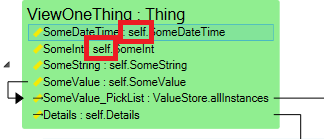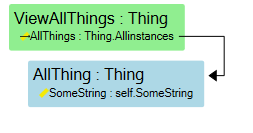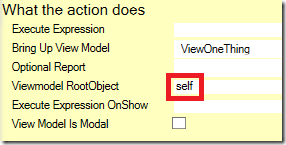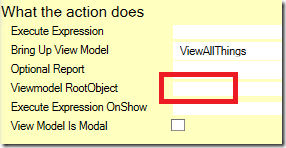ViewModels can either take their starting point in an object you provide as a root or not. If they do, they typically make use of that object – something like this:
The assigned root object is accessed with “self” on the green Root ViewModel class above.
However, a ViewModel may also be constructed without needing a root object. This is the typical case for Seekers or Browsers that look through everything in Class. The Browser pattern is very common for managing small value stores. Like this:
When using this pattern, you do not use “self” in the Root ViewModel class.
Since both these scenarios are legit, it is easy to imagine situations where you “forget” the intention of a ViewModel – was it Rooted, or was it not?
If it was intended to be rooted, the action bringing the ViewModel up should supply a root object like this:
But if it was not intended to be rooted – as in the ViewAllThings case – then there would be no point in submitting a RootObject from the action:
To clarify your intentions, it is a good style to check the “Requires root”-checkbox:
If you make your intentions clear this way, the environment can help you ensure you follow through.
When you have a ViewModel that RequiresRoot, but you have an action that does not supply a RootObject – you get a warning:
“WARNING: If the ViewModel requires a root object [RequiresRootObject on ViewModel] you should not have it empty ViewOneThing”
And if you have a ViewModel that does not Require a Root, but an action submits a RootObject – you get another warning:
“WARNING: The ViewModel does not require a root object [RequiresRootObject on ViewModel] but there is a Expression in ViewModelRootObjectExpressionViewOneThing”





